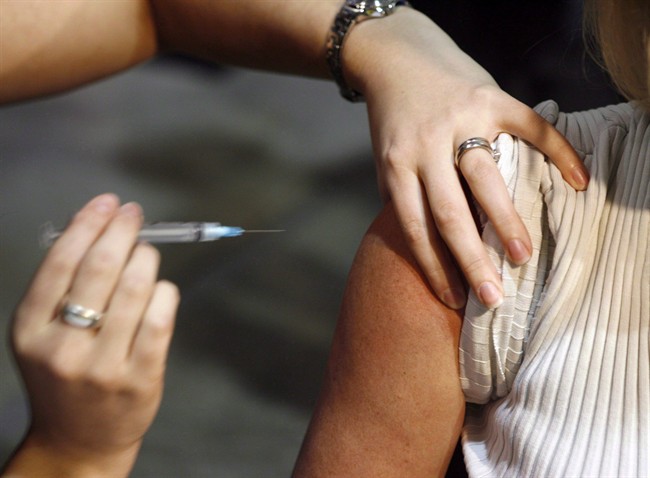TORONTO – This year’s flu shot offered substantial protection to people who received it, new Canadian data suggest.

The vaccine appeared to be about 71 per cent effective against all flu strains, and 74 per cent effective against H1N1, the strain responsible for more than nine in 10 of all confirmed flu infections this year in Canada, the study says.
The research measured how effective the vaccine was at preventing what’s called medically attended influenza – infections where the person was sick enough to seek care from a doctor or a clinic.
The effectiveness rate was significantly better than that seen in a similar study conducted last year by the same group of researchers.
READ MORE: How do you treat the common cold? Here’s what works and what doesn’t
“I think 74 per cent is pretty good, actually. And it’s certainly better than what we measured last year for the H3N2 that was dominating,” said Dr. Danuta Skowronski, an influenza expert at the British Columbia Centre for Disease Control in Vancouver.
In fact, the U.S. Centers for Disease Control estimates that flu vaccine cuts the risk of infection by between 50 to 70 per cent, putting this year’s vaccine at the high end of the effectiveness one might expect from a flu shot, especially one that does not include an adjuvant or boosting compound.
Canada used vaccine with adjuvant in the 2009 pandemic; the vaccine effectiveness was calculated about 93 per cent then. But adjuvants are not used in seasonal flu vaccine in Canada.
The results released Thursday were an interim estimate, calculated in time to help inform the experts who will meet at the World Health Organization later this month to select the viruses that should go into flu vaccine for the 2014-15 Northern Hemisphere winter.
READ MORE: Fever-reducing pills may help spread flu, Canadian study warns
Skowronski said she and her colleagues – from B.C., Alberta, Manitoba, Quebec and Ontario – continue to gather data and will issue a final analysis at the end of the flu season.
The estimate is reached by comparing the flu vaccine status of people who seek care for respiratory illness from participating doctors in the five provinces that take part in the ongoing study. The same patients are also tested to see if their illness is actually caused by flu or one of the numerous other viruses that cause symptoms similar to flu.
Last year this group’s mid-season estimate suggested the flu vaccine was about 45 per cent effective at preventing medically attended influenza. By the end of the season, the vaccine effectiveness estimate had slipped to 40 per cent.
But last year nearly 90 per cent of cases were caused by the H3N2 flu virus, which has been a minor player so far this season.
While people of all ages can be infected by both these strains, the two viruses mainly target different age groups. This year’s H1N1 outbreak has been hitting young and middle-aged adults particularly hard; H3N2 is typically harder on seniors.
This year’s pattern of illness – highlighted in media reports of previously healthy adults dying from flu – triggered huge demand for vaccine in Canada in January, a time when influenza vaccination efforts are typically winding down.
READ MORE: Got the flu? Stay home, and bosses, don’t ask for sick notes: OMA
Many provinces ended up scrambling to buy additional doses to meet the unexpected surge.
The current variety of H1N1 viruses have been around since 2009, when the virus caused a pandemic. In the years since then it has continued to circulate but at lower levels, making up less than 20 per cent of confirmed flu cases each year.
Skowronski said this winter’s strong H1N1 resurgence has led to concerns that the virus may have mutated or that the vaccine isn’t working. But the data in this new study suggest neither is true, she said.
The findings were published in Eurosurveillance, an online public health journal belonging to the European Centre for Disease Prevention and Control.



Comments